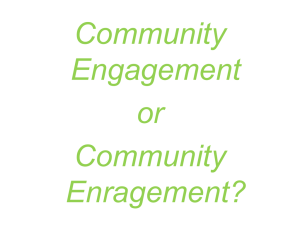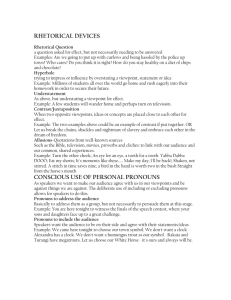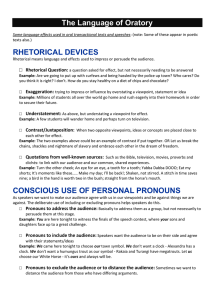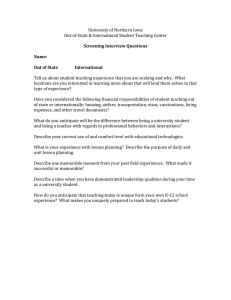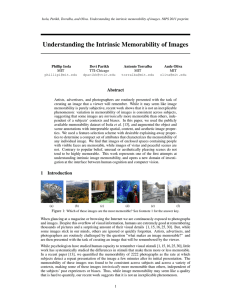What makes an image memorable?
advertisement
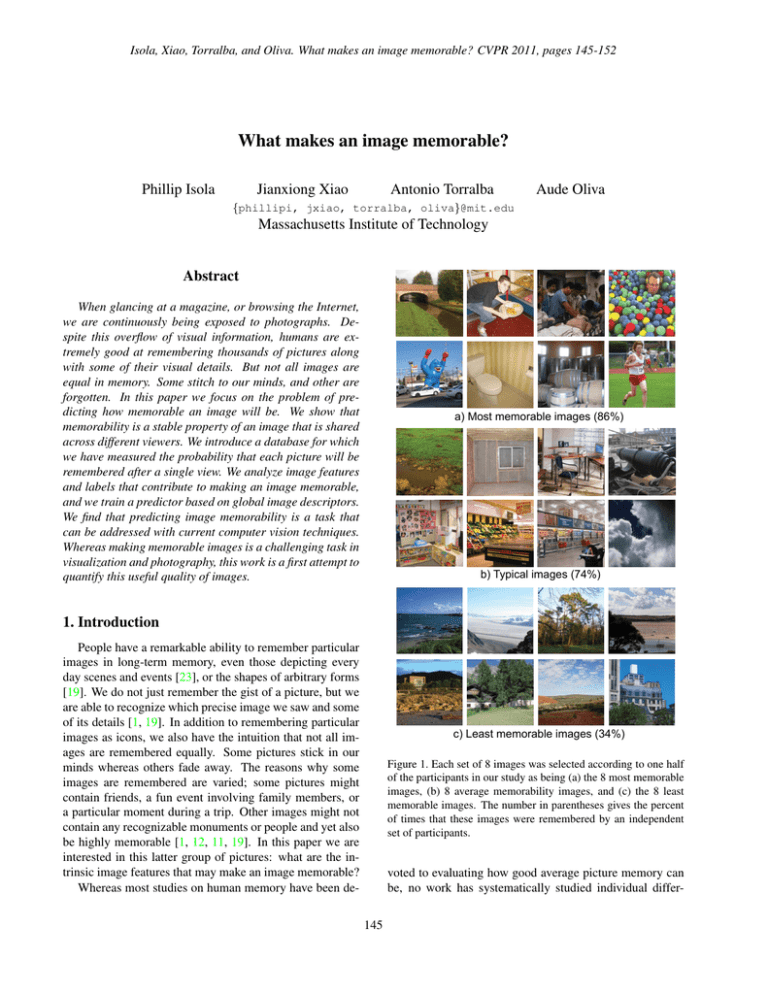
Isola, Xiao, Torralba, and Oliva. What makes an image memorable? CVPR 2011, pages 145-152
What makes an image memorable?
Phillip Isola
Jianxiong Xiao
Antonio Torralba
Aude Oliva
{phillipi, jxiao, torralba, oliva}@mit.edu
Massachusetts Institute of Technology
Abstract
When glancing at a magazine, or browsing the Internet,
we are continuously being exposed to photographs. Despite this overflow of visual information, humans are extremely good at remembering thousands of pictures along
with some of their visual details. But not all images are
equal in memory. Some stitch to our minds, and other are
forgotten. In this paper we focus on the problem of predicting how memorable an image will be. We show that
memorability is a stable property of an image that is shared
across different viewers. We introduce a database for which
we have measured the probability that each picture will be
remembered after a single view. We analyze image features
and labels that contribute to making an image memorable,
and we train a predictor based on global image descriptors.
We find that predicting image memorability is a task that
can be addressed with current computer vision techniques.
Whereas making memorable images is a challenging task in
visualization and photography, this work is a first attempt to
quantify this useful quality of images.
a) Most memorable images (86%)
b) Typical images (74%)
1. Introduction
People have a remarkable ability to remember particular
images in long-term memory, even those depicting every
day scenes and events [23], or the shapes of arbitrary forms
[19]. We do not just remember the gist of a picture, but we
are able to recognize which precise image we saw and some
of its details [1, 19]. In addition to remembering particular
images as icons, we also have the intuition that not all images are remembered equally. Some pictures stick in our
minds whereas others fade away. The reasons why some
images are remembered are varied; some pictures might
contain friends, a fun event involving family members, or
a particular moment during a trip. Other images might not
contain any recognizable monuments or people and yet also
be highly memorable [1, 12, 11, 19]. In this paper we are
interested in this latter group of pictures: what are the intrinsic image features that may make an image memorable?
Whereas most studies on human memory have been de-
c) Least memorable images (34%)
Figure 1. Each set of 8 images was selected according to one half
of the participants in our study as being (a) the 8 most memorable
images, (b) 8 average memorability images, and (c) the 8 least
memorable images. The number in parentheses gives the percent
of times that these images were remembered by an independent
set of participants.
voted to evaluating how good average picture memory can
be, no work has systematically studied individual differ145
Isola, Xiao, Torralba, and Oliva. What makes an image memorable? CVPR 2011, pages 145-152
Figure 2. Sample of the database used for the memory study. The images are sorted from more memorable (left) to less memorable (right).
ences between images and if those differences are consistent across different viewers. Can a specific natural image
be memorable to all of us, and can we estimate what makes
it distinctive?
Similar to other image properties such as photographic
quality, composition, and beauty, image memorability is
likely to depend on the user context and is likely to be subject to some inter-subject variability [9]. However, despite
this expected variability when evaluating subjective properties of images, there is also a sufficiently large degree of
agreement between users that suggests it is possible to devise automatic systems to estimate these properties directly
from images, ignoring user differences. As opposed to other
image properties, there are no previous studies that try to
quantify individual images in terms of how memorable they
are, and there are no computer vision systems that try to
predict image memorability. This is contrary to many other
photographic properties that have been addressed in the literature such as photo quality [16], saliency [10], attractiveness [15], composition [8, 18], color harmony [4], and object importance [22]. Also, there are no databases of photographs calibrated in terms of the degree of memorability
for each image.
In this paper, we characterize an image’s memorability
as the probability that an observer will detect a repetition
of a photograph a few minutes after exposition, when presented amidst a stream of images. This setting allows us
to gather memory data for a large collection of images, and
determine which images left a trace in long-term memory1 .
We mine this data to identify which features of the images
correlate with memorability, and we train memorability predictors on these features. Whereas further studies will be
needed to see if the predictions from this data will apply
to more general viewing conditions, the present work constitutes an initial benchmark. Studying what makes images
memorable, and how to predict memorability from image
information alone, may have many applications, including
choosing a book cover, designing a logo, organizing images
in a photo album, and selecting an image to decorate a website.
2. Is image memorability predictable?
Although we all have the intuition that some images will
capture our attention and will be easier to remember than
others, quantifying this intuition has not been addressed in
previous experiments. Are the images remembered by one
person more likely to be remembered also by somebody
else? In this section, we characterize the consistency of image memory. In order to do so, we built a database depicting
a variety of images (Figure 2), and we measured the probability of remembering each image over a large population of
users. These data allow us to quantify the degree to which
image memory measured on one set of participants is consistent with image memory measured on an independent set
of participants.
2.1. The Memory Game: measuring memorability
In order to measure image memorability, we presented
workers on Amazon Mechanical Turk with a Visual Memory Game. In the game, participants viewed a sequence of
images, each of which was displayed for 1 second, with a
1.4 second gap in between image presentations (Figure 3).
Their task was to press the space bar whenever they saw an
identical repeat of an image at any time in the sequence [1]
[12]. Participants received feedback whenever they pressed
a key (a green symbol shown at the center of the screen for
correct detection, and a gray X for an error).
Image sequences were broken up into levels that consisted of 120 images each. Each level took 4.8 minutes
to perform. At the end of each level, the participant saw
his or her correct response average score for that level, and
was allowed to take a short break. Participants could complete at most 30 levels, and were able to exit the game at
any time. A total of 665 workers from Mechanical Turk
(> 95% approval rate in Amazon’s system) performed the
game. Over 90% of our data came from 347 of these workers. We payed workers $0.30 per level in proportion to the
1 Short-term memory typically can only hold 3 or 4 items at once [5];
since participants in our experiment had to hold many more images in
memory, it is unlikely short term memory was driving performance.
146
Isola, Xiao, Torralba, and Oliva. What makes an image memorable? CVPR 2011, pages 145-152
Figure 3. Mechanical Turk workers played a “Memory Game” in which they watched for repeats in a long stream of images.
amount of the level completed, plus a $0.10 bonus per fully
completed level. This adds up to about $5 per hour. The
average worker stayed in the game for over 13 levels.
Unbeknownst to the participants, the sequence of images was composed of ‘targets’ (2222 images) and ‘fillers’
(8220 images). Target and filler images represented a random sampling of the scene categories from the SUN dataset
[24]. All images were scaled and cropped about their centers to be 256x256 pixels. The role of the fillers was twofold: first, they provided spacing between the first and second repetition of a target; second, responses on repeated
fillers constituted a ‘vigilance task’ that allowed us to continuously check that participants were attentive to the task
[1, 12]. Repeats occurred on the fillers with a spacing of 1-7
images, and on the targets with a spacing of 91-109 images.
Each target was sequenced to repeat exactly once, and each
filler was presented at most once, unless it was a vigilance
task filler, in which case it was sequenced to repeat exactly
once.
Stringent criteria were used to continuously screen
worker performance once they entered the game. First, the
game automatically ended whenever a participant fell below a 50% success rate on the last 10 vigilance task repeats
or above a 50% error rate on the last 30 non-repeat images.
When this happened, all data collected on the current level
was discarded. Rejection criterion reset after each level. If
a participant failed any of the vigilance criteria, they were
flagged. After receiving three such flags they were blocked
from further participation in the experiment. Otherwise,
participants were able to restart the game as many times
as they wished until completing the max 30 levels. Upon
each restart, the sequence was reset so that the participant
would never see an image they had seen in a previous session. Finally, a qualification and training ‘demo’ preceeded
the actual memory game levels.
After collecting the data, we assigned a ‘memorability
score’ to each image, defined as the percentage of correct
detections by participants. On average, each image was
scored by 78 participants. The average memorability score
was 67.5% (SD of 13.6%). Average false alarm rate was
10.7% (SD of 7.6%). As the false alarm rate was low in
comparison with correct detections, correct detections are
1
0.9
95
Group 1
Group 2
90
Chance level
85
80
75
0.8
Spearman’s rank correlation
Average memorability for top N ranked images (%)
100
0.7
0.6
0.5
0.4
0.3
0.2
70
0.1
65
0
200
400
600
800
1000 1200 1400 1600 1800 2000 2200
Image rank (N)
0
0
20 40 60 80
Mean number of scores
per image
Figure 4. Measures of human consistency. Participants were split
into two independent sets, group 1 and group 2. Left: Images
were ranked by memorability scores from participants in group
1 and plotted against the cumulative average memorability scores
given by participants in the two groups. Right: Spearman’s rank
correlation between subject groups 1 and 2 as a function of the
mean number of scores per image. Both left and right analyses
were repeated for 25 random splits and mean results are plotted.
Error bars show 80% confidence intervals over the 25 trials.
unlikely to be lucky confusions. Specifically, we expect
lucky confusions to account for no more than 10.7% of correct detections on average. Therefore, we believe our memorability scores are a good measure of correct memories.
2.2. Consistency analysis
To evaluate human consistency, we split our participant
pool into two independent halves, and quantified how well
image scores measured on the first half of the participants
matched image scores measured on the second half of the
participants. Averaging over 25 random split half trials,
we calculated a Spearman’s rank correlation (ρ) of 0.75 between these two sets of scores. We additionally examined
consistency with a variant of a precision-recall task: We
sorted the images by their score given by the first half of the
participants and then calculated cumulative average memorability, according to the second half of the participants, as
we move across this ordering (Figure 4). For example, if we
select the top 100 most memorable images according to the
147
Isola, Xiao, Torralba, and Oliva. What makes an image memorable? CVPR 2011, pages 145-152
first half of the participants (whose average memorability
for this set is 93%), the second half of the participants will
give an average memorability of 85% for that set. Figure
1 shows sample image sets selected and measured in this
fashion. This analysis shows how high human-to-human
memorability consistency can be.
Thus, our data has enough consistency that it should be
possible to predict image memorability. Individual differences and random variability in the context each participant
saw add noise to the estimation; nonetheless, this level of
consistency suggests that information intrinsic to the images might be used by different people to remember them.
In the next section, we search for this image information.
UDQNFRUU ï
UDQNFRUU ï
0.6
0.4
0.2
0.8
0.6
0.4
0.2
0
50 100 150 200 250
intensity mean
1
memorability score
0.8
0
3. What makes an image memorable?
0
rank corr = 0.07
3.1. Color and simple image features
Are simple image features enough to determine whether
or not an image will be memorable? We looked at the
correlation between memorability and basic pixel statistics.
Mean hue was weakly predictive of memory: as mean hue
transitions from red to green to blue to purple, memorability
tends to go down (ρ = -0.16). This correlation may be due to
blue and green outdoor landscapes being remembered less
frequently than more warmly colored human faces and indoor scenes. Mean saturation and value, on the other hand,
as well as the first three moments of the pixel intensity histogram, exhibited weaker correlations with memorability
(Figure 5). These findings concord with other work that has
shown that perceptual features are not retained in long term
visual memory [11]. In order to make useful predictions,
more descriptive features are likely necessary.
0.4
0.2
2
4
log number of objects
0.4
0.2
6
0.8
0.6
0.4
0.2
0
0
intensity skewness
5
UDQNFRUU ï
1
memorability score
memorability score
memorability score
0.6
0
0.6
0
ï
5000
10000
intensity variance
1
0.8
0
0.8
UDQNFRUU ï
1
Among the many reasons why an image might be remembered by a viewer, we investigate first the following
factors: color, simple image features, object statistics, object semantics, and scene semantics.
UDQNFRUU ï
1
memorability score
memorability score
1
6
8
10
12
log mean class coverage
0.8
0.6
0.4
0.2
0
9
10
11
12
log max class coverage
Figure 5. Simple image features, as well as non-semantic object
statistics, do not correlate strongly with memorability score.
over object classes) did not correlate strongly with memorability (ρ = 0.07, -0.06, and -0.09 respectively) (Figure 5).
To investigate the role of more subtle interactions between these statistics, we trained a support vector regression
(�-SVR [2]) to map object statistics to memorability scores.
For each image, we measured several object statistics: the
number of objects in the image per class, and the number of
pixels covered by objects of each class in the entire image
as well as in each quadrant of the image. For each of these
statistics, we thereby obtained joint distribution on (object
class, statistic). We then marginalized across class to generate histograms of ‘Object Counts’, ‘Object Areas’, and,
concatenating pixel coverage on the entire image with pixel
coverage per quadrant, ‘Multiscale Object Areas’. We used
these histograms as features for our regression and applied
histogram intersection kernels.
For each of 25 regression trials, we split both our image
set and our participant set into two independent, random
halves. We trained on one half of the images, which were
scored by one half of the participants, and tested on the left
out images, which were scored by the left out participants.
During training, we performed grid search to choose cost
and � hyperparameters for each SVR.
We quantified the performance of our predictions similarly to how we analyzed human consistency above. First,
we calculated average ρ between predicted memorabilities and empirically measured memorabilities. Second,
we sorted images by predicted score and selected various
3.2. Object statistics
Object understanding is necessary to human picture
memory [13]. Using LabelMe [20], each image in our target set was segmented into object regions and each of these
segments was given an object class label by a human user
(e.g “person,” “mountain,” “stethoscope”) (see [3] for details). In this section, we quantify the degree to which our
data can be explained by non-semantic object statistics.
Do such statistics predict memorability? For example do
the number of objects one can attach to an image determine
its memorability, or is it critical that an object class takes up
a large portion of an image in order for the image to stick
in memory? We find the answer to be no: none of these
statistics make good predictions on their own. Simple object statistics (log number of objects, log mean pixel coverage over present object classes, and log max pixel coverage
148
Isola, Xiao, Torralba, and Oliva. What makes an image memorable? CVPR 2011, pages 145-152
Top 20
Top 100
Bottom 100
Bottom 20
ρ
Object
Counts
Object
Areas
68%
68%
67%
67%
0.05
67%
68%
64%
63%
0.05
Multiscale
Object
Areas
73%
73%
64%
65%
0.20
Object
Label
Presences
84%
79%
57%
55%
0.43
Labeled
Object
Counts
82%
79%
57%
54%
0.44
Labeled
Object
Areas
84%
82%
56%
53%
0.47
Labeled
Multiscale
Object Areas
84%
82%
56%
52%
0.48
Scene
Category
81%
78%
57%
55%
0.37
Objects
and
Scenes
85%
82%
55%
53%
0.50
Other
Humans
86%
84%
47%
40%
0.75
Table 1. Comparison of predicted versus measured memorabilities. Images are sorted into sets according to predictions made on the basis
of a variety of object and scene features (denoted by column headings). Average empirically measured memorabilities are reported for
each set. e.g. The “Top 20” row reports average empirical memorability over the images with the top 20 highest predicted memorabilities.
ρ is the Spearman rank correlation between predictions and measurements.
ranges of images in this order, examining average empirical
memorability on these ranges (Table 1). As a baseline, we
compared to a measure of the available consistency in our
data, in which we predicted that each test set image would
have the same memorability according to our test set participants as was measured by our training set participants
(‘Other Humans’).
Quantified in this way, our regressions on object statistics appear ineffective at predicting memorability (Table 1).
However, predictions made on the basis of the Multiscale
Object Areas did begin to show substantial correlation with
measured memorability scores (ρ = 0.20). Unlike the Object Counts and Object Areas, the Multiscale Object Areas
are sensitive to changes across the image. As a result, these
features may have been able to identify cues such as “this
image has a sky,” while, according to the other statistics,
a sky would have been indistinguishable from a similarly
large segment, such as a closeup of a face.
and 0.20 respectively). Moreover, Scene Category, which
just gives a single label per image, appears to summarize
much of what makes an image memorable (ρ = 0.37), and
we do best when we combine both object and scene semantic information (ρ = 0.50). These performances support the
idea that object and scene semantics are a primary substrate
of memorability [11, 12, 13].
3.4. Visualizing what makes an image memorable
Since object content appears to be important in determining whether or not an image will be remembered, we
further investigated the contribution of objects by visualizing object-based “memory maps” for each image. These
maps shade each object according to how much the object
adds to, or subtracts from, the image’s predicted memorability. More precisely, to quantify the contribution of an
object i to an image, we take a prediction function, f , that
maps object features to memorability scores and calculate
how its prediction m changes when we zero features associated with object i from the current image’s feature vector,
(a1 , · · · , an ). This gives us a score si for each object in a
given image:
3.3. Object and scene semantics
As demonstrated above, objects without semantics are
not effective at predicting memorability. This is not surprising given the large role that semantics play in picture
memory [13, 11]. To investigate the role of object semantics, we performed the same regression as above, except this
time using the entire joint (object class, statistic) distributions as features. This gave us histograms of ‘Labeled Object Counts’, ‘Labeled Object Areas’, ‘Labeled Multiscale
Object Areas’, and, thresholding the labeled object counts
about zero, ‘Object Label Presences’. Each image was also
assigned a scene category label as described in [24] (‘Scene
Category’). As before, we applied histogram intersection
kernels to each of these features. We also tested a combination of Labeled Multiscale Object Areas and Scene Category using a kernel sum (‘Objects and Scenes’).
Semantics boosted performance (Table 1). Even the Object Label Presences alone, which simply convey a set of semantic labels and otherwise do not describe anything about
the pixels in an image, performed well above our best unlabeled object statistic, Multiscale Object Areas (ρ = 0.43
m1
m2
si
= f (a1 , · · · , ai , · · · , an )
(1)
= m1 − m2
(3)
= f (a1 , · · · , 0, · · · , an )
(2)
For the prediction function f , we use our SVR on Labeled
Multiscale Object Areas, trained as above, and we plot
memory maps on test set images (Figure 7). Thus, these
maps show predictions as to what will make a novel image either remembered or not remembered. The validity of
these maps is supported by the fact that the SVR we used to
generate them (the Labeled Multiscale Object Areas regression) makes predictions that correlate relatively well with
measured memory scores (ρ = 0.48, see Table 1).
This visualization gives a sense of how objects contribute
to the memorability of particular images. We are additionally interested in which objects are important across all
images. We estimated an object’s overall contribution as
its contribution per image, calculated as above, averaged
149
Isola, Xiao, Torralba, and Oliva. What makes an image memorable? CVPR 2011, pages 145-152
person (+0.061)
person sitting (+0.053)
floor (+0.027)
seats (+0.023)
car
tree ï
mountain
(+0.020)
Top
objects
building
ceiling ï
ï
sky
(ï
ï
Bottom
objects
Figure 6. Objects sorted by their predicted impact on memorability. Next to each object name we report how much an image’s predicted
memorability will change, on average, when the object is included in the image’s feature vector versus when it is not. For each object
name, we also display two test set images that contain the object: on the left is the example image with the highest memorability score
among all test set images that contain (over 4000 pixels of) the object. On the right is the example with the lowest score. Only objects that
appear (cover over 4000 pixels) in at least 20 images in our training set are considered.
across all test set images in which it appears with substantial size (covers over 4000 pixels). This method sorts
objects into an intuitive ordering: people, interiors, foregrounds, and human-scale objects tend to contribute positively to memorability; exteriors, wide angle vistas, backgrounds, and natural scenes tend to contribute negatively to
memorability (Figure 6).
Our analysis of object semantic regressions demonstrate
that if a system knows which objects an image contains,
it is able to predict memorability with a performance not
too far from human consistency. But, how far can we go
in predicting the memorability of a novel image without an
object labeling stage? In other words, can we get the same
utility based just off unlabeled image features?
Top 20
Top 100
Bottom 100
Bottom 20
ρ
Pixels
74%
72%
61%
59%
0.22
GIST
82%
78%
58%
57%
0.38
SIFT
83%
79%
57%
56%
0.41
SSIM
83%
79%
58%
56%
0.43
HOG
2x2
83%
80%
57%
55%
0.43
map from features to memorability scores – this time using only features algorithmically extracted from the images.
We tested a suite of global image descriptors that have been
previously found to be effective at scene recognition tasks
[24] as well as being able to predict the presence/absence of
objects in images [7, 6, 21]. The facility of these features at
predicting image semantics suggests that they may be able
to predict, to some degree, those aspects of memorability
that derive from image semantics.
These global features are GIST [17], SIFT [14],
HOG2x2 [7, 6, 24], and SSIM [21]. We additionally looked
at pixel histograms. We used an RBF kernel for GIST and
histogram intersection kernels for the other features. Lastly,
we also combined all these features with a kernel product
(‘All Global Features’).
We evaluated performance in the same way as we evaluated the object regressions, and we found that the combination of global features performs best, achieving a rank
correlation of 0.46. This correlation is less than human predictions, but close to our best predictions from labeled annotations. Figure 8 shows sample images from predicted
sets. Figure 10 shows sample images on which our global
features regression performed poorly.
To set a high watermark, and to get a sense of the redundancy between our image features and our annotations,
we additionally trained an SVR on a kernel sum of all our
global features plus Labeled Multiscale Object Areas and
Scene Categories (‘Global Features and Annotations’). This
combination achieved a rank correlation of 0.54. See Table
2 and Figure 9 for detailed results.
All Global
Features
83%
80%
56%
54%
0.46
Table 2. Comparison of global feature predictions versus empirically measured memory scores. Uses same measures as described
in Table 1.
4. Predicting image memorability: The role of
global features
As we have seen in the previous sections there is a significant degree of consistency between different sets of viewers on how memorable are individual images. In addition,
we have seen that some of the consistency can be explained
in terms of the objects present in the picture and the scene
category. In order to build a predictor of how memorable
an image is, we used similar approaches to works studying
other subjective image properties [16, 18, 24].
As with the object regressions, we trained an SVR to
5. Conclusions
Making memorable images is a challenging task in visualization and photography, and is generally presented as a
vague concept hard to quantify. Surprisingly, there has been
no previous attempt to systematically measure this property
on image collections, and to apply computer vision tech150
Isola, Xiao, Torralba, and Oliva. What makes an image memorable? CVPR 2011, pages 145-152
a) Predicted as highly memorable (91%)
a) Predicted most memorable (87%)
b) Predicted as typical memorability (68%)
b) Predicted typical memorability (68%)
c) Predicted least memorable (52%)
c) Predicted as unmemorable (55%)
ï
Figure 8. The 8 images predicted, on the basis of global image features, as being the most memorable out of all test set images (a),
8 images with average memorability predictions (b), and the 8 images predicted as being the least memorable of all test set images
(c) . The number in parentheses gives the mean empirical memorability score for images in each set. The predictions produce
clear visual distinctions, but may fail to notice more subtle cues
that make certain images more memorable than others.
Figure 7. Visualization of how each object contributes to the memorability of sample images spanning a range of memorability predictions. We estimate contribution as the difference between predicted memorability when the object is included in the image versus when it is removed from the image. In red we show objects
that contribute to higher predicted memorability and in blue are
objects that contribute to lower predicted memorability. Brightness is proportional to the magnitude of the contribution. Average
measured memorability of each sample set is given in parentheses.
puter vision techniques. We have measured memorability
using a restricted experimental setting in order to obtain a
meaningful quantity: we defined an image’s memorability
score as the probability that a viewer will detect a repeat of
the image within a stream of pictures. We have shown that
there is a large degree of consistency among different viewers, and that some images are more memorable than others
even when there are no familiar elements (such as relatives
or famous monuments). This work is a first attempt to quantify this useful quality of individual images. In future work
it will be interesting to investigate the relationship between
image memorability and other measures such as object im-
niques to extract memorability automatically. Measuring
subjective properties of photographs is an active domain of
research with numerous applications. For instance, image
memorability could be used to extract, from a collection of
images, the ones that are more likely to be remembered by
viewers. This could be applied to selecting images for illustrations, covers, user interfaces, etc.
In this paper we have shown that predicting image memorability is a task that can be addressed with current com151
Average memorability for top N ranked images (%)
Isola, Xiao, Torralba, and Oliva. What makes an image memorable? CVPR 2011, pages 145-152
85
Pixels
All Global Features
GIST
Objects and Scenes
SIFT
Global Features and Annotations
SSIM
Other Humans
1016862 to A.O, CAREER Awards No. 0546262 to A.O and No.
0747120 to A.T. A.T. was supported in part by the Intelligence Advanced Research Projects Activity via Department of the Interior
contract D10PC20023, and ONR MURI N000141010933.
HOG 2x2
References
80
[1] T. F. Brady, T. Konkle, G. A. Alvarez, and A. Oliva. Visual long-term
memory has a massive storage capacity for object details. Proc Natl
Acad Sci, USA, 2008. 145, 146, 147
[2] C.-C. Chang and C.-J. Lin. LIBSVM: a library for support vector
machines, 2001. 148
[3] M. J. Choi, J. J. Lim, A. Torralba, and A. S. Willsky. Exploiting
hierarchical context on a large database of object categories. CVPR,
2010. 148
[4] D. Cohen-Or, O. Sorkine, R. Gal, T. Leyvand, and Y. Xu. Color
harmonization. ToG, 2006. 146
[5] N. Cowan. The magical number 4 in short-term memory: A reconsideration of mental storage capacity. Behavioral and Brain Sciences,
2001. 146
[6] N. Dalal and B. Triggs. Histograms of oriented gradients for human
detection. In CVPR, 2005. 150
[7] P. F. Felzenszwalb, R. B. Girshick, D. McAllester, and D. Ramanan.
Object detection with discriminatively trained part-based models.
PAMI, 2010. 150
[8] B. Gooch, E. Reinhard, C. Moulding, and P. Shirley. Artistic composition for image creation. In Proc. of the 12th Eurographics workshop
on Rendering Techniques, 2001. 146
[9] R. Hunt and J. Worthen. Distinctiveness and Memory. New York,
NY: Oxford University Press, 2006. 146
[10] L. itti, C. Koch, and E. Niebur. A model of saliency-based visual
attention for rapid scene analysis. PAMI, 1998. 146, 152
[11] T. Konkle, T. F. Brady, G. A. Alvarez, and A. Oliva. Conceptual
distinctiveness supports detailed visual long-term memory for realworld objects. JEP:G, 2010. 145, 148, 149
[12] T. Konkle, T. F. Brady, G. A. Alvarez, and A. Oliva. Scene memory
is more detailed than you think: the role of categories in visual longterm memory. Psych Science, 2010. 145, 146, 147, 149
[13] W. Koutstaal and D. Schacter. Gist-based false recognition of pictures in older and younger adults. Journal of Memory and Language,
1997. 148, 149
[14] S. Lazebnik, C. Schmid, and J. Ponce. Beyond bags of features:
Spatial pyramid matching for recognizing natural scene categories.
In CVPR, 2006. 150
[15] T. Leyvand, D. Cohen-Or, G. Dror, and D. Lischinski. Data-driven
enhancement of facial attractiveness. ToG, 2008. 146
[16] Y. Luo and X. Tang. Photo and video quality evaluation: Focusing
on the subject. In ECCV, 2008. 146, 150, 152
[17] A. Oliva and A. Torralba. Modeling the shape of the scene: a holistic
representation of the spatial envelope. IJCV, 2001. 150
[18] L. Renjie, C. L. Wolf, and D. Cohen-or. Optimizing photo composition. Technical report, Tel-Aviv University, 2010. 146, 150
[19] I. Rock and P. Englestein. A study of memory for visual form. The
American Journal of Psychology, 1959. 145
[20] B. C. Russell, A. Torralba, K. P. Murphy, and W. T. Freeman. LabelMe: a database and web-based tool for image annotation. IJCV,
2008. 148
[21] E. Shechtman and M. Irani. Matching local self-similarities across
images and videos. In CVPR, 2007. 150
[22] M. Spain and P. Perona. Some objects are more equal than others:
Measuring and predicting importance. In ECCV, 2008. 146, 152
[23] L. Standing. Learning 10,000 pictures. Quarterly Journal of Experimental Psychology, 1973. 145
[24] J. Xiao, J. Hayes, K. Ehinger, A. Oliva, and A. Torralba. Sun
database: Large-scale scene recognition from abbey to zoo. In
CVPR, 2010. 147, 149, 150
75
70
0
100
200
300
400
500
600
700
Image rank (N)
800
900
1000
Figure 9. Comparison of regressions results averaged across 25
random split half trials. Images are ranked by predicted memorability and plotted against the cumulative average of empirically
measured memorability scores. Error bars omitted for clarity.
a) Prediction too high (+919/1111)
b) Prediction too low (-­948/1111)
Figure 10. The 8 images whose predicted memorability rank, on
the basis of global features, most overshot empirical memorability rank (a) and most undershot empirical memorability rank (b).
The mean rank error between predicted and measured ranks across
each set of images is given in parentheses.
portance [22], saliency [10], and photo quality [16].
Acknowledgments: We would like to thank Timothy Brady
and Talia Konkle for helpful discussions and advice. This work
is supported by the National Science Foundation under Grant No.
152


